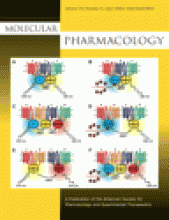Abstract
Upon binding of the corticotropin-releasing factor (CRF) analog sauvagine to the type 1 CRF receptor (CRF1), the amino-terminal portion of the peptide has been shown to lie near Lys257 in the receptor's second extracellular loop (EL2). To test the hypothesis that EL2 residues play a role in the binding of sauvagine to CRF1 we carried out an alanine-scanning mutagenesis study to determine the functional role of EL2 residues (Leu251 to Val266). Only the W259A, F260A, and W259A/F260A mutations reduced the binding affinity and potency of sauvagine. In contrast, these mutations did not seem to significantly alter the overall receptor conformation, in that they left unchanged the affinities of the ligands astressin and antalarmin that have been suggested to bind to different regions of CRF1. The W259A, F260A, and W259A/F260A mutations also decreased the affinity of the endogenous ligand, CRF, implying that these residues may play a common important role in the binding of different peptides belonging to CRF family. Parallel amino acid deletions of the two peptides produced ligands with various affinities for wild-type CRF1 compared with the W259A, F260A, and W259A/F260A mutants, supporting the interaction between the amino-terminal residues 8 to 10 of sauvagine and the corresponding region in CRF with EL2 of CRF1. This is the first time that a specific region of CRF1 has been implicated in detailed interactions between the receptor and the amino-terminal portion of peptides belonging to the CRF family.
Footnotes
-
This work was supported by PENED [grant cofinanced by E.U.-European Social Fund (75%) and the Greek Ministry of Development-GSRT (25%)].
-
ABBREVIATIONS: CRF, corticotropin-releasing factor; CRF1, type 1 receptor for the corticotropin-releasing factor; GPCR, G-protein-coupled receptor; EL, extracellular loop; Fmoc, 9-fluorenylmethoxycarbonyl; tBu, tert-butyl; TFA, trifluoroacetic acid; RP, reversed phase; AcN, acetonitrile; HEK, human embryonic kidney; WT, wild type; PBS, phosphate-buffered saline.
- Received October 1, 2008.
- Accepted January 5, 2009.
- The American Society for Pharmacology and Experimental Therapeutics
MolPharm articles become freely available 12 months after publication, and remain freely available for 5 years.Non-open access articles that fall outside this five year window are available only to institutional subscribers and current ASPET members, or through the article purchase feature at the bottom of the page.
|






